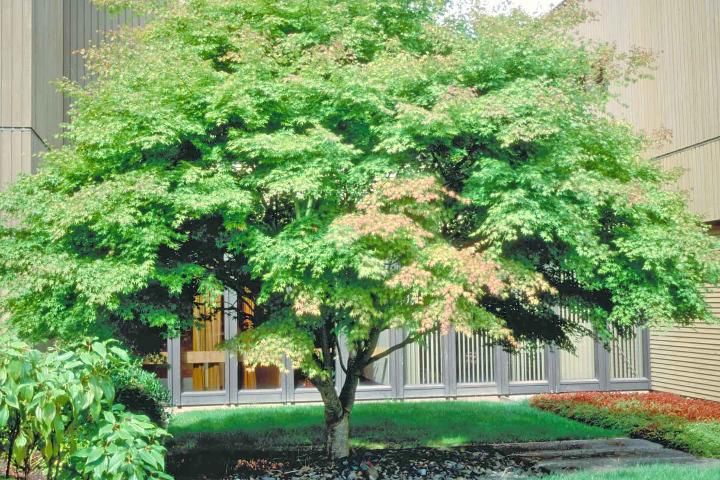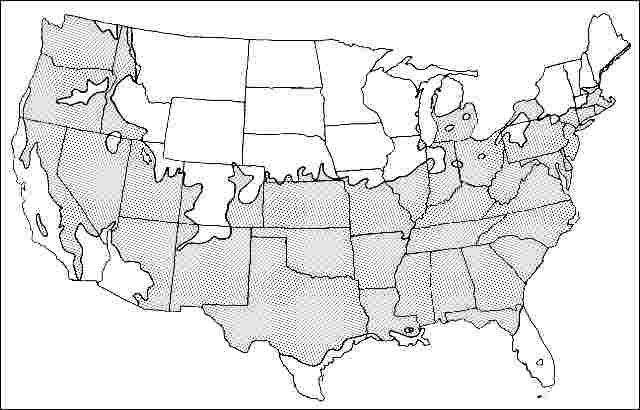Introduction
Japanese maple has a height and spread of about 20 feet, but there are much smaller selections available. The multiple trunks are muscular-looking, picturesque, grey, and show nicely when lit up at night. Japanese maple is grown for its green or red colored leaves, interesting growth habit and fine leaf texture. Fall color ranges from bright yellow through orange and red, and is often striking, even on trees grown in total shade. Growth habit varies widely depending on cultivar from globose, branching to the ground to upright, vase-shaped. The globose selections look best when they are allowed to branch to the ground. Be sure to clear all turf away from beneath the branches of these low growing types so the lawn mower will not damage the tree. The more upright selections make nice patio or small shade trees for residential lots, and, with pruning to remove drooping branches, provide adequate clearance for pedestrian traffic to pass close to the tree. More compact cultivars make wonderful accents for any landscape.

Credit: Ed Gilman
General Information
Scientific name: Acer palmatum
Pronunciation: AY-ser pal-MAY-tum
Common name(s): Japanese maple
Family: Aceraceae
USDA hardiness zones: 5B through 8B (Fig. 2)
Origin: not native to North America
Invasive potential: little invasive potential
Uses: specimen; deck or patio; container or planter; trained as a standard; Bonsai
Availability: not native to North America

Description
Height: 15 to 25 feet
Spread: 15 to 25 feet
Crown uniformity: symmetrical
Crown shape: vase, round
Crown density: moderate
Growth rate: slow
Texture: medium
Foliage
Leaf arrangement: opposite/subopposite (Fig. 3)
Leaf type: simple
Leaf margin: serrate, lobed
Leaf shape: star-shaped
Leaf venation: palmate
Leaf type and persistence: deciduous
Leaf blade length: 2 to 4 inches
Leaf color: green
Fall color: red, orange, yellow, copper
Fall characteristic: showy

Flower
Flower color: red
Flower characteristics: not showy
Fruit
Fruit shape: elongated
Fruit length: .5 to 1 inch
Fruit covering: dry or hard
Fruit color: red
Fruit characteristics: does not attract wildlife; not showy; fruit/leaves not a litter problem
Trunk and Branches
Trunk/bark/branches: branches droop; showy; typically multi-trunked; no thorns
Pruning requirement: needed for strong structure
Breakage: resistant
Current year twig color: green, reddish
Current year twig thickness: thin
Wood specific gravity: unknown
Culture
Light requirement: partial sun or partial shade, shade tolerant
Soil tolerances: clay; sand; loam; slightly alkaline; acidic; well-drained
Drought tolerance: moderate
Aerosol salt tolerance: none
Other
Roots: not a problem
Winter interest: yes
Outstanding tree: no
Ozone sensitivity: unknown
Verticillium wilt susceptibility: susceptible
Pest resistance: resistant to pests/diseases
Use and Management
This large shrub or small tree tends to leaf out early, so it may be injured by spring frosts. Protect them from drying winds and direct sun by providing exposure to partial or filtered shade and well-drained, acid soil with plenty of organic matter, particularly in the southern part of its range. Leaves often scorch in hot summer weather in USDA hardiness zones 7b and 8, unless they are in some shade or irrigated during dry weather. More direct sun can be tolerated in the northern part of the range. Be sure drainage is maintained and never allow water to stand around the roots. Grows fine on clay soils as long as the ground is sloped so water does not accumulate in the soil. Responds well to several inches of mulch placed beneath the canopy.
Variegated types are a bit more difficult to grow and are subject to leaf scorch. There are many cultivars of Japanese maple with a wide variety of leaf shapes and color, growth habits, and sizes: 'Atropurpureum—reddish leaves with five lobes; 'Bloodgood'—new foliage bright red, darkening to dark green; 'Burgundy Lace'—reddish foliage and cut leaves; 'Dissectum'—finely dissected leaves in green or red, 10 to 12 feet tall; 'Elegans'—leaves with rose-colored margins when they first unfold; 'Ornatum'—foliage is cut and reddish.
Pests
Aphids infest maples, usually Norway maple, and may be numerous at times. High populations can cause leaf drop. Another sign of heavy aphid infestation is honey dew on lower leaves and objects beneath the tree. Aphids are controlled by spraying or they may be left alone. If not sprayed, predatory insects will bring the aphid population under control.
Scales are an occasional problem on maples. Perhaps the most common is cottony maple scale. The insect forms a cottony mass on the lower sides of branches. Scales are usually controlled with horticultural oil sprays. Scales may also be controlled with well-timed sprays to kill the crawlers.
If borers become a problem it is an indication the tree is not growing well. Controlling borers involves keeping trees healthy. Chemical controls of existing infestations are more difficult. Proper control involves identification of the borer infesting the tree then applying insecticides at the proper time.
Diseases
Scorch occurs during periods of high temperatures accompanied by wind. Trees with diseased or inadequate root systems will also show scorching. When trees do not get enough water they scorch. Scorch symptoms are light brown or tan dead areas between leaf veins. The symptoms are on all parts of the tree or only on the side exposed to sun and wind. Scorching due to dry soil may be overcome by watering. If scorching is due to an inadequate or diseased root system, watering may have no effect.
Nutrient deficiency symptoms are yellow or yellowish-green leaves with darker green veins. The most commonly deficient nutrient on maple is manganese. Implanting capsules containing a manganese source in the trunk will alleviate the symptoms. Test soil samples to determine if the soil pH is too high for best manganese availability. Plants exposed to weed killers may also show similar symptoms.
Tar spot and a variety of leaf spots cause some concern among homeowners but are rarely serious enough for control.